Hi! I'm a student of film directing and I want to share with you my college essay about films of Michael Haneke, one of my favorite directors.
It's divided by films, and I guess, it's necessary that the reader has watched them in order to understand what I'm writing about, I didn't bother to put too much effort in explaining the plot.
Hope you enjoy it!
______________________________________________________________________________
''When a director announces "I wish you a disturbing evening" before the showing of his latest film, you probably are not in for an easy ride.
If he says it with cheerful abandon, you have all the more reason to take him seriously. ''
(critics about Michael Haneke)
_______________________________________________________________________________
Funny Games: the aesthetics of violence
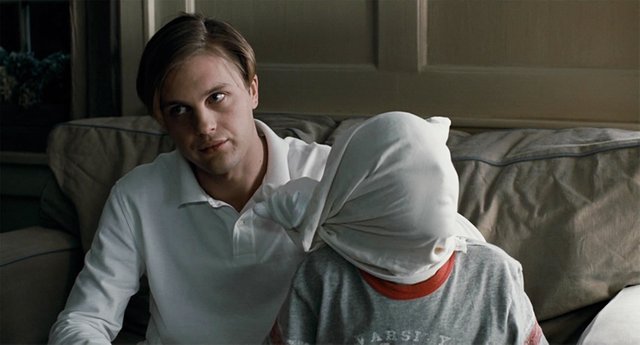
This film may seem like it is a conventional violent thriller film, but in reality it is Haneke’s attempt to criticize the thriller genre and it’s audience’s lust for violence and blood .
With Funny Games, Haneke criticize what the protagonist of contemporary cinema have become : ultra-violent murderers who hold the Machiavellian view that end justifies the means. Paul and Peter, the protagonist and the murderers of Funny Games, are not meant to be sympathetic characters. This is contrasted, however, by their clothing; they wear white throughout the whole film. In classical Hollywood cinema, the heroes always wear the white color, ride a white horse etc. In Funny Games, the murderers wear white. Through this device, Haneke relates Paul and Peter to the protagonist of conventional violent thriller or action films.
In a interview with Richard Falcon, Haneke argues, that ‘’in order to attack a genre, you first have to establish it.’’
Funny Games is an exceptionally violent film, but very little violence is seen in screen. This is one of the key differences between Funny Games and most other ultra-violent films; it denies the mainstream viewer exactly what he is expecting from this film. By denying the viewer on screen-violence, Haneke is condemning the audience’s desire for such violence. When violence occurs off-screen, the viewer may feel cheated by the film; in traditional cinema the camera would follow the action of the scene.
The horror in Funny Games is based on the fact that the situation the protagonist are facing is at the same time terrible and absurd. This contradiction between the ‘’normal’’ and the ‘’senseless’’ provides a space for empathetic understanding on the viewer’s part, one that involves him/her in a critical process as well. The contradiction in question is established from the very beginning of the film : as the Schober family is driving to their holiday home, the soundtrack changes without warning from elevated sound of George Frederic Handel to John Zorn’s aggressive heavy metal. At the level of rational understanding, neither the Schobers nor the audience have any access to the world with which they will soon be confronted.
The nightmarish situation in which the Schobers find themselves in Funny Games has the capacity to touch the audience deeply. Anna and George cannot protect their son or themselves. From that moment, right up to the end of the film, we are involved i a ‘’game’’ that we cannot accept or explain, one which isn’t ‘’funny’’ at all- not for the terrorized family, and not for the viewer who is terrorized as well- because he or she can’t help but identify with the victims.
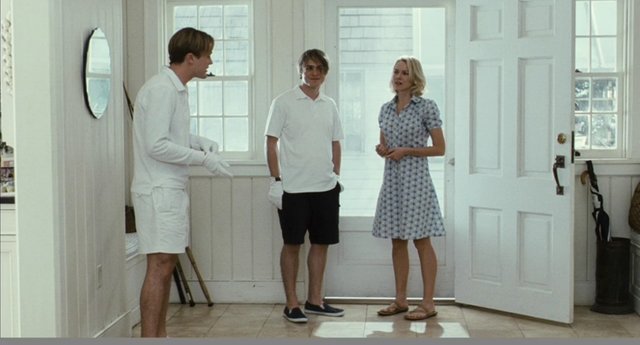
The Schobers and the audience are asking the killers the same question: ‘’Why are you doing this?’’ And all they get are ridiculous answers that cannot take seriously. Paul explains Peter’s actions by referring to him as a ‘’spoiled child tormented by ennui and world weariness, weight down by the void of existence’’, at the same time winking directly to the camera.
This meta-level of the film is meant to invite the audience to share the point of view of the psychopathic killers. Peter and Paul are constantly looking straight to the camera and addressing the audience directly: ‘’Do you think they will have a chance? You are on their side, so who will you bet with?’’
The Scobers suffering does not stop, because the audience is willing to keep watching. But of course there is no pleasure in Funny Games for the audience, because we are empathetically involved with the victims. By inviting the viewer to empathize so strongly with the victims of violence, Haneke manages to depict violence not as entertainment. In Haneke’s own words : ‘’I give back to violence that which is : a pain, a violation of others’’.
Benny's Video
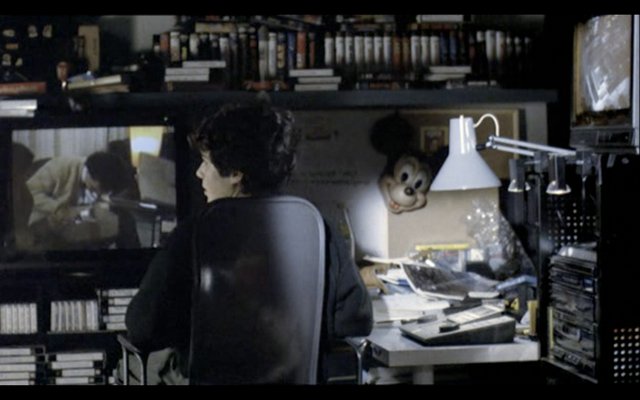
For his second feature film ''Benny’s Video'', Michael Haneke’s focus remained on his pet subject of alienated individuals who react against the moral laws and commonly accepted norms of social behavior. Benny is a neglected son of rich parents in Vienna. He watches gory horror films in his bedroom, left to his own devices by parents who pride themselves on making sure he has his freedom. Benny's most prized clip is the slaughter of a pig that he filmed himself. Benny watches it repeatedly, playing it in slow motion, studying the pixels of violent death.
These scenes of rewinding serve to take the viewer out of the moment, to remind us that we are viewers, to detach us from our involvement in the unfolding story, to position us as consumers of video – and in this respect, we are brought into uncomfortable proximity to Benny himself who, much like the titular 'hero' of John McNaughton's Henry: Portrait of a Serial Killer (1986), likes to document and review his experiences – experiences that seem somehow more real to him when framed, captured and controlled through the distance offered by a screen.
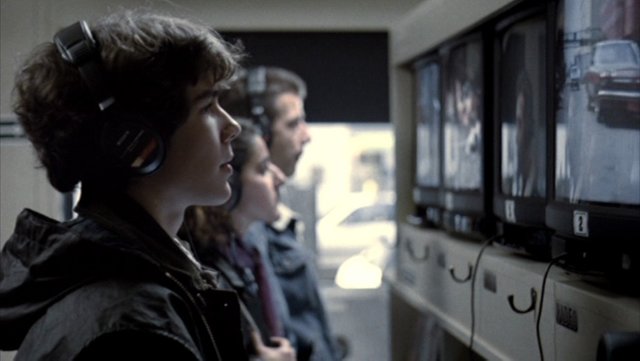
Benny’s Video is aesthetically and formally conventional. Thus, for example, when Benny brings the girl back to his place after meeting her at the video store,we think : boy meets girl, girl meets boy, boy kisses girl… but instead, in this film, boy meets girl, boy kills girl.
This film's objective is to analyze and deconstruct the effects rather than senselessly guess their causes - an approach that is effectively distancing, but which creates horrific undertones to the events that follow. After seemingly connecting with a young girl outside the video store he frequents, the two go back to his house, have a snack and begin videotaping one another during their conversation. For reasons left unexplained, and most likely unknown to even Benny himself, he pulls out the pellet gun and shoots her in the chest. Haneke's framing of this scene is crucial - Benny pushes the girl back a step so the video camera captures them and Haneke's camera pushes in showing the murder on the television where it is being recorded. He literally inserts himself into one of the violent digital narratives to which he has become addicted, yet his response seems almost inhuman. He expresses concern for the girl, but after failing to calm her down, finishes the execution and cleans up the blood with the same robotic precision with which he cleans up spilt milk in a later scene.
The film is shot documentary-like, apparently distancing from making any overt commentary or statement, but the implication is nonetheless quite clear : Benny has been turned into a sociopath by his consumption of violent images. Violent imagery on our TV screen is killing youthful innocence. It's black and white. The audience cannot come to any other conclusion. Haneke has decided for us.
It is also significant that the film’s central and most disturbing scene of violence is seen entirely from the perspective of a video monitor.
The Piano Teacher
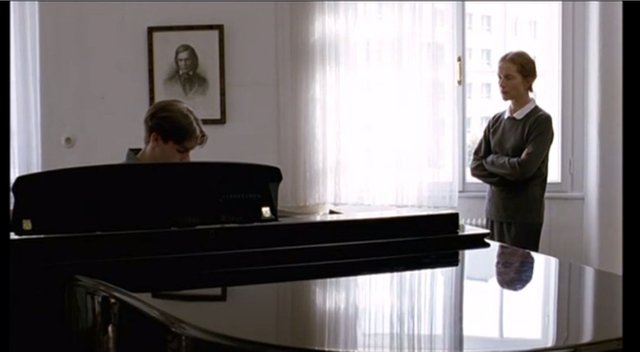
The protagonist of La Pianiste is Erika Kohut, a middle-age piano teacher .
Erika teaches at a conservatory, having never quite managed to make a career for herself as concert pianist, for reasons that are not spelled right out in the film: possibly it's just that she's not quite good enough. Standing like a well-groomed martinet over her students, she seems to be willing them to fail. Erika lives with her mother and her father is dying in a mental institution. There are many words that one could use to describe this mother/daughter relationship. 'Healthy' is not one of them
Haneke presents her sexual masochism as a pathological sublimation of her repressed emotions and abusive relationship with her mother. It seems that every one of Erika’s scenes of “perversion” are represented as effects whose causation lies in the traumatic events of her personal life. It is after she gets into an argument with her over-protective mother during a rehearsal that she goes to the peep show to watch porn. Soon, a young self-assured Walter enters the picture.
Intelligent, handsome and cockily charming, Walter becomes Erika's lover, and for one brief moment it seems he might be her salvation. But the moment passes, and when Walter is introduced to Erika's inner world of sadism and degradation, the chance of any light penetrating the intolerable depression disapear.
The irony of Erika's perversities is the graceful surrounding of noble music and culture and is one of the more compelling attributes of the film.
Her activities may seem grotesque, but they are essentially harmless, until Erika becomes more extreme, elegantly quoting Schubert on madness and “the twilight of the mind” in one scene and cutting her genitals with a razorblade in the next. Then she turns her violence on others, jealously filling one of her gifted student (Ana) coat pockets with broken glass in order to mutilate her hands.
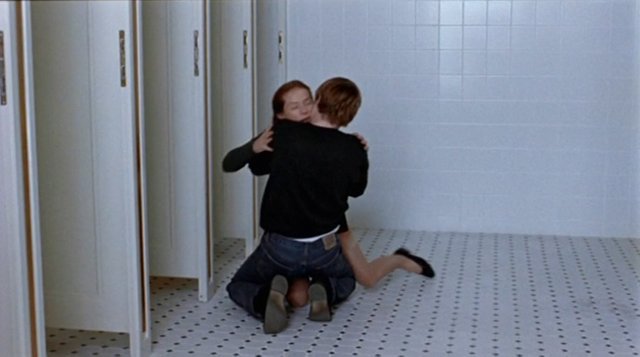
Erika's exploratory but unexplained story is told from behind the walls of her apartment, which has been turned into an asylum without any possible escape. It's a place where porn and Schubert fuse together and one cannot beat out the other in her twisted mind, as she plays the piano by the rules she wholly believes but is nevertheless on the road to self-destruction. She will in the end stab herself near the heart for some kind of perverted martyrdom to prove her love of music. Why she can't relate to people but by some set of rules, is just one of her many problems. But it is this problem that leads her on to a point where she loses track of where art and life take separate roads, and she's left only with madness. Her music rules can't help her in real life, as they also couldn't help either Schubert or Schumann.
Why are there only two ways to have sex with somebody in The Piano Teacher— the “normal” romantic way or the sick, “transgressive” way? And why does the film make Walther look merely troubled, while Erika is downright psychotic, as if that’s the inevitable destination of dabblers in deviance? Great art-porn appeals to our stereotypical notions of kinky behavior and playing with our disgust, challenging us by making us uncomfortable, forcing us to go one step further and question the nature of what we think is deviant and why.
Shot with many close-ups, director Haneke explores a deep rooted psychological drama, backed with graceful Schubert music.
One might question if Haneke has gone too far and created a character that is too sick and demented for audiences to identify with in any way. But we know that's not true.
The most controversial element of "The Piano Teacher" is that there might be something buried deep in all of us that connects us closer to Erika than we would like. This uncomfortable thought will linger long after the film.
To get at the root psychology of this film would require many sessions on the couch of Dr. Freud.
The White Ribbon : Michael Haneke’s pessimistic study of society
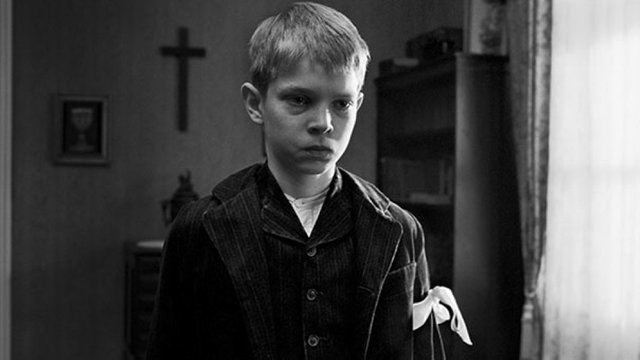
‘’The scariest monsters aren’t the ones you see but the ones you don’t. ‘’
The setting is a feudal community in Germany, immediately before the First World War. A village doctor is injured when his horse is felled by a tripwire. Soon there are other unexplained incidents, including the death of a farmhand and the torture of the baron's son, who is found hanging by his feet after a sound thrashing. The common factor appears to be the proximity of a group of local children.
Good and evil are black and white, every action has it reaction, and the punishment will come to those who committed wrong. Children are in the age when they realize this. When you don-t fallow rules you will be punished. We see this in a scene where siblings are entering the room, but the camera stays outside, showing us just the door during the abuse. They have to wear the white ribbon to show to world their transgression and need to earn back right to be free.
Haneke wanted to show the sort of ‘’black’’ education that was going on at the time, fascism and terror. The children represent a generation that will grow up and become a Nazi party.
They are the key to mysterious events that are going on in the village. But can we believe that they are monsters? O, it couldn’t be children, right? They are innocent.
But if the children are the perpetrators of the violence, it is their elders who have nurtured these dubious talents.
Haneke criticises the early twentieth century Protestant type of upbringing that punished children for signs of sexual awakening, and even for simple displays of anger in the classroom, with caning and other cruel measures such as tying them to a bed
The only flicker of humanity comes from the sensitive, liberal-minded village schoolteacher/narrator in his courting of the lovely but sexually repressed farmer’s daughter Eva. Her abusive father , who embodies the pure malice of the Wilhelmine patriarchy, is visibly torn between his desire to get rid of his elder daughter (“You can see how many other goddamn mouths I have to fill”) and his obvious delight in tormenting the poor teacher by postponing the young people’s marriage as long as possible.
In the end, there is no solution to the mystery; it could be that history and human agency are unknowable, untreatable, or it could be that the Nazi generation grew up with frustration of not getting a solution – and the director wishes us to hear the malign echoes of that word.
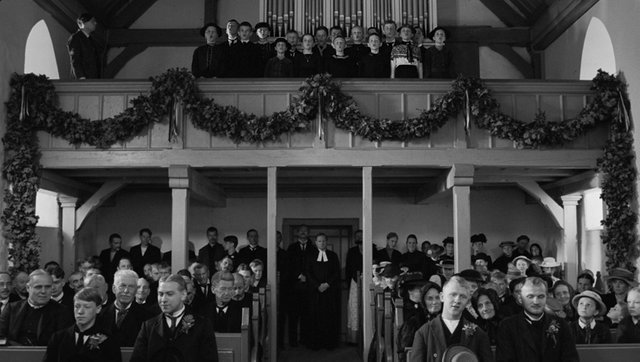
Haneke belongs to a generation of filmmakers that have drawn the most pessimistic lessons from the world wars and the terror of fascism. They explain the lapse into fascist barbarism by invoking the collective guilt of the whole population, and draw the conclusion that any progressive development of humanity involving a mass social movement is impossible.
Fantastic essay! Yes, Haneke is indeed obsessed about violence, in its various forms, undoubtedly influenced by growing up in Germany/Austria during World War II's aftermath.
I particularly like that he examines what would drive regular people into violence, rather than portray antagonistic characters. However, I don't find all his films particularly engaging, they sometimes do tend to get lost in his own obsessions over creating a cinematic experience. The White Ribbon, however, is pretty much perfect and one of the finest films this century.
Downvoting a post can decrease pending rewards and make it less visible. Common reasons:
Submit
Thank you! Yeah that's why chose these particular films that have different approach violence.
I saw you are writing reviews too, followed you!
Downvoting a post can decrease pending rewards and make it less visible. Common reasons:
Submit